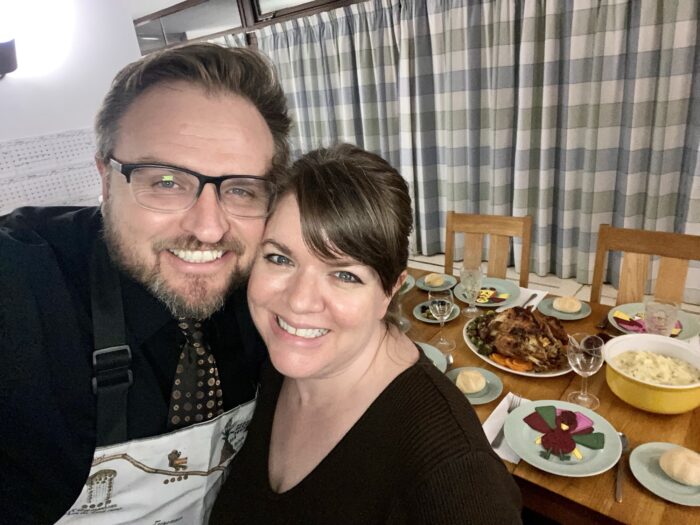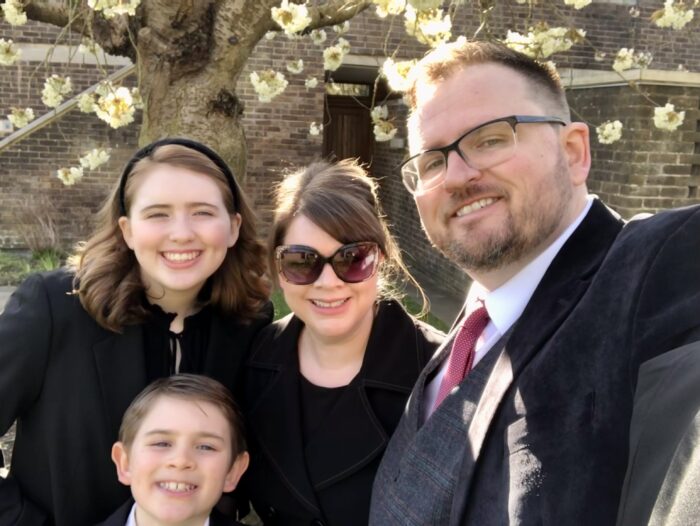Dr Joshua Fitzgerald spent his childhood scrambling around the red rocks and cornfields of rural Utah, USA, never having an inkling he’d one day be a researcher with the University of Cambridge. Now a specialist in the history and art history of Nahua communities of Central Mexico, he works across disciplines “to bring attention to indigenous perspectives from the past that continue to be relevant and invaluable.”
Since being awarded a Jeffrey Rubinoff Junior Research Fellowship (JRF) in 2020, and joining the College with his family, it’s fair to say Josh has made the most of the opportunities available. Alongside publishing numerous articles and presenting at conferences he has also ‘discovered’ a sixteenth century manuscript at the University Library and co-convened the College’s first ever Latin American focused music and culture activity! We met with Josh to find out more about his experiences as a JRF at the College, as well as his plans for the future.
For a poor farm boy from rural Utah to currently be researching and teaching for some of the world’s most highly-regarded Faculty, departments and museums in the world, I think it is safe to say that Cambridge offers people a world of possibilities. JRFs are highly competitive opportunities to become part of a College family, and I feel very lucky to have had so many Churchillians welcome my family and me into their lives.
Where did you study prior to coming to Cambridge?
I completed my History BA at the University of Utah where I also took immersive Nahuatl language courses with support from the Zacatecas Institute for Teaching and Research in Ethnology (IDIEZ). I then completed my MA and PhD in History at the University of Oregon alongside a Museum Studies certification.
What first inspired you to develop an interest in this area?
I was first inspired to study my specific line of research at the University of Utah, sitting in Anthropology courses under a portrait of Charles Dibble. I wondered, who’s this old guy in flowing robes and what did he do to deserve a portrait? It turned out Dibble had studied the Mexican native language Nahuatl and co-edited the first full English translation of the Florentine Codex when at the U of U. My undergrad mentor, Rebecca Horn then spurred me to study his papers in the Marriot Library and, next, to continue my research with her fellow UCLA-cohort of Nahuatl experts Robert Haskett and Stephanie Wood at the University of Oregon.
Why did you decide to apply to be a JRF at Churchill?
The Jeffrey Rubinoff JRF offers the researcher an unparalleled opportunity to engage in interdisciplinary research in the Arts, Humanities and Social Sciences (AHSS) in a meaningful way. STEM-rich Churchill College’s members care deeply about the Arts and Humanities, as seen in its promising commitment to creative expression in the Bill Brown Creative Workshops. My work explores the theme of ‘art as source of knowledge’ in the context of Mesoamerican and Indigenous-Colonial learning science, visual and material culture and built forms, and this interest in the scientific study of History’s diversity of learning modalities and art as an archive melded well with Churchill.
Moreover, my JRF has been enriched with annual visits to Rubinoff’s Sculpture Park on Hornby Island, Canada, to participate in their Company of Ideas Forum, a dynamic research community of artists, scholars, postgraduates and curators. I hope the work I have accomplished helps to show the range of Jefferey Rubinoff’s mission to inform in a meaningful way via art and historical study. The Indigenous perspectives I study continue to be relevant and invaluable to understanding past expressions of knowledge through visual and material culture.
What have you been involved with since joining the College?
I have striven to spark inquiry and inform the UK about the importance of Indigenous Heritage Studies, Latin American cultural history and the Arts. My first book is under review with Cambridge University Press, and I have been able to publish articles that have extended my research interests, present dozens of papers throughout the UK and at international conferences, work closely with Cambridge’s world-renowned library and museum professionals and co-develop cross-discipline networking opportunities and public engagement programming. Cambridge’s Museum of Archaeology and Anthropology (MAA) has been a constant source of collaboration for me, and I have guest curated for exhibitions, researched their collection and created public engagement experiences with the MAA curators and staff.
In April 2023, I “discovered” a sixteenth century manuscript written in Nahuatl and Latin at the Cambridge University Library. Only a handful of these types of manuscripts exist, and for an upcoming Munby Fellowship in Bibliography 2024-25 I will have the chance to tell its story and identify some of the ways that its authors adopted and adapted ecclesiastics at a critical time in Nahua-Christian history. For the College specifically, I had the honour of co-convening the first ever Latin American themed musical and cultural activity in July 2023, when ethnomusicologist Christopher Garcia performed traditional instruments for our fellowship and the Cambridge public in the Chapel at Churchill College. That’s a win in my history book.
What have been your highlights at Churchill thus far?
Call me a sucker for the romantics, but I have always marked Burns Night as a yearly treat. The festivities are always ‘wreaking’ with fun, and Amber (my partner) and I truly enjoy listening as the bagpipes fill the Dining Hall. Academically, some of the most rewarding experiences have been teaching supervisions and lecturing for students in History, Archaeology, and the Centre for Latin American Studies. Watching my students take to a research topic and discussing their interpretations about the past inspires me to return to my primary sources. It is a gift to learn from each devoted student cohort. A cherished research highlight, though, was my archival work at the Biblioteca Medicea Laurenziana in Florence, Italy, when I was able to study the original Florentine Codex. I cannot express the feeling of wonder felt holding that manuscript, thinking back to my undergrad days of lugging around all 13 parts of Dibble’s translation throughout the Marriot Library at the University of Utah. There is still so much left to be learned from Nahua archives.
What do you do in your spare time?
My family is central to my free time. My kids and I like to nuzzle into hours of board games, video gaming or movie nights. Dungeons & Dragons campaigns have become fairly popular in the flat, and, personally, I enjoy (poorly) painting my kids’ intricate D&D figurines or piecing together jigsaw puzzles. Otherwise, we like touring the U.K. and make time for new museum exhibitions in Cambridge and London.
What are your career aspirations?
I am set on advancing my research and teaching as a full professor. I feel fortunate to have another year of research ahead with the Cambridge University Library, especially considering my project on such a fascinating, understudied Nahuatl manuscript. These are precarious times for AHSS early-career scholars, so I continue to develop transferable skills that will help me find a place in a related educational role. A deeply rooted interest in working with museums and archives and the Digital Humanities, too, will guide me toward dynamic public education projects in collections. In the long term, I would feel fulfilled by working more with colleagues and communities in Mexico. I hope the significance of my research contributions will help bring attention to Indigenous communities’ concerns throughout the Americas. As a lover of the art, history and archaeology of Mexico, I have found the Rubinoff JRF has been the most amazing catapult for this and all my many aspirations.
Links & further information
Blog posts


